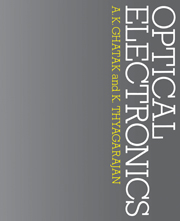Book contents
- Frontmatter
- Contents
- Preface
- 1 Maxwell's equations and propagation of electromagnetic waves
- 2 Reflection and refraction of electromagnetic waves
- 3 Wave propagation in anisotropic media
- 4 Fraunhofer diffraction
- 5 Fresnel diffraction
- 6 Spatial frequency filtering
- 7 Holography
- 8 Lasers: I
- 9 Lasers: II
- 10 Some laser systems
- 11 Electromagnetic analysis of the simplest optical waveguide
- 12 Leaky modes in optical waveguides
- 13 Optical fibre waveguides
- 14 Integrated optics
- 15 The electrooptic effect
- 16 The strain optic tensor
- 17 Acoustooptlc effect: Raman–Nath diffraction
- 18 Acoustooptic effect: Bragg diffraction
- 19 Acoustooptic devices
- 20 Nonlinear optics
- Appendices
- References and suggested reading
- Index
15 - The electrooptic effect
Published online by Cambridge University Press: 05 June 2012
- Frontmatter
- Contents
- Preface
- 1 Maxwell's equations and propagation of electromagnetic waves
- 2 Reflection and refraction of electromagnetic waves
- 3 Wave propagation in anisotropic media
- 4 Fraunhofer diffraction
- 5 Fresnel diffraction
- 6 Spatial frequency filtering
- 7 Holography
- 8 Lasers: I
- 9 Lasers: II
- 10 Some laser systems
- 11 Electromagnetic analysis of the simplest optical waveguide
- 12 Leaky modes in optical waveguides
- 13 Optical fibre waveguides
- 14 Integrated optics
- 15 The electrooptic effect
- 16 The strain optic tensor
- 17 Acoustooptlc effect: Raman–Nath diffraction
- 18 Acoustooptic effect: Bragg diffraction
- 19 Acoustooptic devices
- 20 Nonlinear optics
- Appendices
- References and suggested reading
- Index
Summary
Introduction
In Chapter 3 we studied light propagation through anisotropic media aod found that, in general, the state of polarization of the light beam may change as it propagates through the medium. In the present chapter we shall discuss light propagation through crystals in the presence of an externally applied electric field. This field can in general, alter the refractive indices of the crystal and thus could induce birefringence in otherwise isotropic crystals, or could alter the birefringence property of the crystal. This effect is known as the electrooptic effect. If the changes in the refractive indices are proportional to the applied electric field, such an effect is known as the Pockels effect or the linear electrooptic effect. If the changes in indices are proportional to the square of the applied electric field, the effect is referred to as the quadratic electrooptic effect or the Kerr effect.
In this chapter we shall study in detail the Pockels effect and obtain expressions for the phase shift suffered by a beam propagating through a crystal which is being acted upon by an external electric field. We will show that under certain geometrical configurations, the applied electric field acts differently on two linearly polarized light waves passing through the crystal and thus one can introduce an electric field dependent retardation between the two polarizations. We shall show in Sections 15.2 and 15.3 that such an effect can be used to control the amplitude of the light beam in accordance with the applied field.
- Type
- Chapter
- Information
- Optical Electronics , pp. 461 - 500Publisher: Cambridge University PressPrint publication year: 1989
- 2
- Cited by



